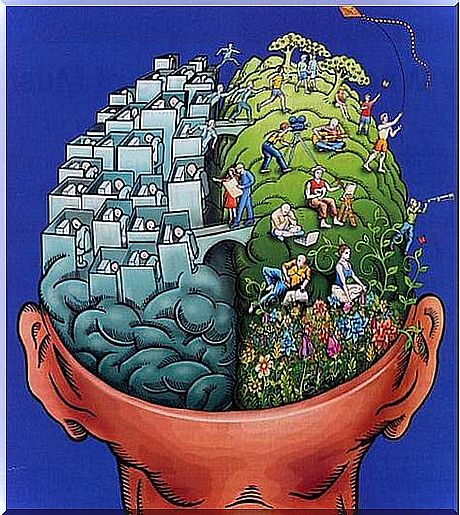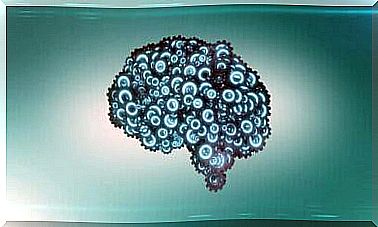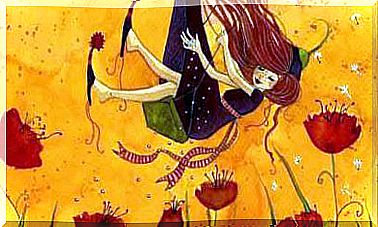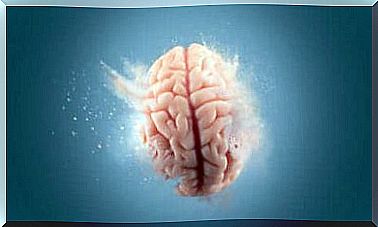Happiness Is In The Left Hemisphere

The real focus of our feelings and emotions is not in the heart. It is actually found in the brain. Even more, as recent studies reveal, a good part of our happiness resides in the left hemisphere. So whenever we feel excited, filled with energy, positivity, and hope, the area with the most neuronal activity is precisely the left prefrontal cortex.
This subject is very interesting. Daniel Goleman wrote about it in a New York Times article. He explained, for example, how in recent years, neurosciences, psychology, Buddhism and spirituality have forged links to find common answers on this subject.
We know that in May 2000, a meeting was held that was as productive as it was rewarding. The Dalai Lama indeed spoke with the best neurologists and psychologists of the moment. Its goal was as high as it was practical: to understand how Buddhism deals with negative emotions. Know what is happening in the brain of a person who is used to meditating. And to use (apparently) a mental approach based on kindness, altruism and happiness.
This meeting lasted 5 days, in a remote location in Dharamsala, India. What is certain is that it has been very fruitful for these scientists. Dr. Richard Davidson, director of the Affective Neuroscience lab at the University of Wisconsin and author of books like The Emotional Life of Your Brain, returned from this meeting with a working hypothesis in mind.

Happiness is in your left hemisphere
Dr. Richardson is known for his studies in affective neuroscience. After years of work and analysis in his laboratory at the University of Wisconsin, he repeats in his lectures the same sentence, the same comment: the basis of a healthy brain is kindness. To this day, he chairs the Healthy Minds Research Center at the same university.
In 2008, he conducted a study demonstrating the relationship between neuroplasticity and meditation techniques. In other words, those people who are used to carrying out this practice for a good part of their life (meditating from time to time has no real effect) exhibit greater electrical activity. Greater ability to concentrate. To learn and generate new neural connections.
On the other hand, if we go back to his book The Emotional Life of Your Brain, released in 2012, we find one of his most interesting theories. The one that says, quite simply, that happiness resides in the left hemisphere of our brain. We will give you more information on this idea later in our article.
The frontal lobes and our emotions
As we have evolved as a species, this mass of a thousand million neurons located inside our skull has specialized. So, to say that happiness resides in the left hemisphere is nothing more than a way of expressing how and in what way our positive emotions have also developed over time.
- For example, not long ago, this whole universe of feelings and emotions was thought to reside in this more primitive area of our inner brain. The same one also called “reptilian brain”. It is in this area that, indeed, these older structures such as the limbic system are located, responsible for regulating all these emotional processes.
- However, it’s been thirty years since neuroscience made another discovery. We already know that emotions do not stay exclusively in this deep brain cave that is the limbic system. In fact, this structure is directly connected to the frontal lobes (involved in more complex thinking such as executive functions).

Anxiety, stress and anxiety are found in the right hemisphere
Doctor Richard Davidson was already starting from this base. In other words, he already knew the relationship between the limbic system and the frontal lobes. However, after a few years of research and through MRI tests, he was able to observe something captivating:
- The functional images revealed that when we feel anxious, stressed or depressed, the most active areas of the brain are the circuits that converge in the amygdala. As in the right prefrontal cortex.
- This area, the right prefrontal cortex, is linked to hypervigilence. Something very common in these times when we are experiencing high stress.
The left hemisphere and positive emotions
Happiness resides in your left hemisphere, or more specifically, in your left frontal lobe. So when we feel most calm, optimistic, and relaxed, our right frontal lobe exhibits less activity, which contrasts with the intense neural activity in the left area.
This is very interesting information, a reality that neurosciences give as valid and which can undoubtedly serve us to carry out another reflection.
If happiness is in your left hemisphere, how can you stimulate that area?
Dr. Davidon points out that the best way to change the activity of our brain is to improve our thoughts, our mental activity. This is something confirmed by certain therapeutic approaches such as cognitive behavioral therapy. The latter is more than ideal for treating depression, anxiety, phobias, stress, etc.
So, if happiness resides in your left hemisphere and you want to “silence” this hyperactivity of the right cerebral lobe area, we advise you to consider the following dimensions:
– Meditate – Show
kindness
– Help others
– Devote time to rest
– Cultivate friendship
– Pursue a goal, have motivation
– Be enthusiastic
– Be positive, have faith in hope
To conclude, beyond where there is a certain process, a certain quality or a certain competence, there is an aspect that we cannot leave aside.
We have the obligation to pass through this more relaxed, open and flexible lifeline. Where to sit the real neurological bases of happiness.










